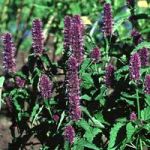
|
| Anise Mint |
Many agastaches have fragran foliage, their scents ranging from anise to mint and citrus. The leaves are used to make herbal tea, for flavoring, and in medicines, while the ornamental flower spikes, which attract beneficial insects, make a pretty addition to salads.
Anise hyssop (A. foeniculum) is a hardy perennial with a sweet anise scent. Both balsamic and peppermint-pennyroyal scented forms are available.
Erect perennial with pointed, ovate leaves, 5-8cm (2-3in), with pale undersides and a strong aniseed scent. Light purple flowers, with conspicuous bracts, appear in dense spikes, to 8cm (3in) in summer.
Sow agastache seed in spring; just cover the seed with soil. It takes 6 to 8 weeks to germinate. Plant in pots when large enough. Established plants produce many basal shoots in spring. Propagate these as softwood cuttings and plant outside in summer, or multiply plants by root division. |
|
Use the leaves and flowers freshly picked, or dry them by haning them upside down in small bunches away from direct sunlight. The will retain their color and scent. |
|
Has white flowers Height: 45-60cm (18-24in) |
|
The flowers of anise hyssop yield large quantities of nectar, which was popular with North American beekeepers in the 19th century for producing a faintly aniseed-flavored honey. Native American Indians used it as a tea and a sweetener. Infuse the dry leaves to make a hot or cold drink. Also, use them to season lamb, chicken, or salmon. Add the seeds to cakes and muffins. Use the flowers or fresh leaves of anise hyssop in salads. |
|
The Complete Illustrated Book of Herbs by Reader's Digest Copyright©2009 The Reader's Digest Association, Inc. Pg. 15 |